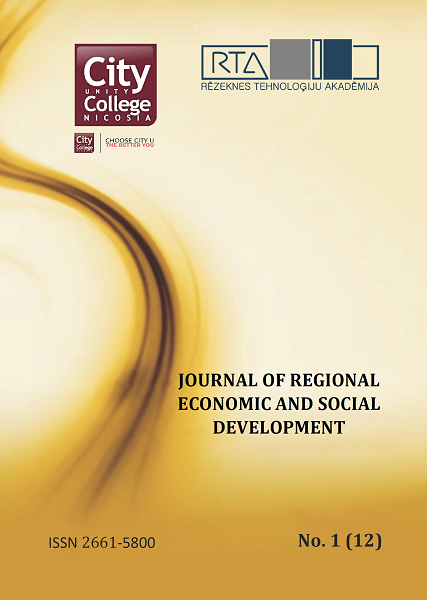SOME ASPECTS OF BEE POPULATION PRESERVATION
DOI:
https://doi.org/10.17770/jresd2020vol1.12.5386Keywords:
bees, neonicotinoids, normative acts, pesticidesAbstract
Destructive influence of pesticides on bee population, as well as on people and the environment has been analysed in the research paper. The aim of the paper is to define topical issues, which have to be solved in order to protect bee population and offer the solutions for bee protection against using of chemicals. The issues of bee population protection have been examined in the context of people and environment protection by the assistance of the systematic method. The comparative method serves in order to view the hazard of bee population in different countries. The development of the normative acts, which regulate bee protection from the impact of pesticides has been discussed by the assistance of the historical method. The following hypothesis has been put forward: the protection of bee population is possible via improvement of the normative legal framework, which refers to the usage of pesticides. The novelty of the research is the offer of a normative act amendment, which would provide the checking of pesticide usage in municipalities.
Downloads
References
Augu aizsardzības līdzekļu lietošanas noteikumi (2011). Ministru kabineta noteikumi Nr.950. Pieejams: https://likumi.lv/ta/id/241853-augu-aizsardzibas-lidzeklu-lietosanas-noteikumi
Augu aizsardzības likums (1998). Latvijas Vēstnesis, (Nr.388/399). 30.12.1998.
Bee health (2019).Retrieved from http://www.efsa.europa.eu/en/topics/topic/bee-health
Buiķe, I. (2018). Neonikotinoīdi aizliegti – vai ar bitēm būs viss kārtībā? Rerieved from https://ir.lv/2018/05/02/neonikotinoidi-aizliegti-vai-ar-bitem-bus-viss-kartiba/
Direktīva 2010/21/ES (2010). Retrieved from https://eur-lex.europa.eu/legal-content/LV/TXT/?uri=CELEX%3A32010L0021
Direktīva 79/409/EEK (1979). Retrieved from https://eur-lex.europa.eu/eli/dir/1979/409/oj/?locale=LV
Direktīva 2009/128/EK (2009). Retrieved from https://eur-lex.europa.eu/legal-content/lv/TXT/?uri=CELEX%3A32009L0128
Eiropas Komisija (2018). Komisijas Paziņojums Eiropas Parlamentam, Padomei, Eiropas Ekonomikas un Sociālo Lietu Komitejai un Reģionu Komitejai, ES Apputeksnētāju iniciatīva , Retrieved from https://op.europa.eu/en/publication-detail/-/publication/e038c9ea-657f-11e8-ab9c-01aa75ed71a1/language-lv/format-PDF
Eiropas SAvienības oficiālais vēstnesis (2012). Līgums par Eiropas Savienības darbību. Retrieved from https://eur-lex.europa.eu/resource.html?uri=cellar:88f94461-564b-4b75-aef7-c957de8e339d.0015.01/DOC_3&format=PDF
European Food Safety Authority (2013a). EFSA Guidance Document on the risk assessment of plant protection products on bees (Apis mellifera, Bombus spp. and solitary bees. Retrieved from https://efsa.onlinelibrary.wiley.com/doi/epdf/10.2903/j.efsa.2013.329512.
European Food Safety Authority (2013b). Outline of the revision of the Guidance on the risk assessment of plant protection products on bees (Apis mellifera, Bombus spp. and solitary bees). Retrieved from http://www.efsa.europa.eu/sites/default/files/event/Bee_Guidance_review.pdf
European Food Safety Authority (2020c). Bees and pesticides: third consultation on guidance review. Retrieved from http://www.efsa.europa.eu/en/news/bees-and-pesticides-third-consultation-guidance-review
European Red List of Bees (2014). Luxembourg: Publications Office of the European Union, 2014.
Grīnvalde, Ž. (2017). Vai Latvijas medū ir pesticīdi? Grēko bišu maizes ražotāji. Retrieved from https://laukos.la.lv/vai-latvijas-medu-ir-pesticidi
Gulbinska, P. (2017). Kaitīgais nezāļu apkarotājs glifosāts: Nav pārspīlēti teikt, ka tas ir visur. Retrieved from https://lr1.lsm.lv/lv/raksts/zinamais-nezinamaja/kaitigais-nezalu-apkarotajs-glifosats-nav-parspileti-teikt-ka-ta.a82413/
International ANSES-EFSA Scientific Conference Day Organised by: ANSES – EFSA (2019). Retrieved from https://www.anses.fr/en/content/international-anses-efsa-scientific-conference-day
Latvijas Administratīvo pārkāpumu kodekss (1985). Latvijas Padomju Sociālistiskās Republikas Augstākās Padomes un Valdības Ziņotājs (Nr. 51). 20.12.1984.
Latvijas biškopības programma 2020–2022. gadam (2019). Retrieved form http://www.lad.gov.lv/files/ladDocument/1832/LV_biskopibas_programma_2020-2022.pdf
Latvijas sabiedriskie mediji (2019). Savācot miljonu parakstu par bišu glābšanu, pilsoņi varēs prasīt EK reakciju. Retrieved from https://www.lsm.lv/raksts/zinas/latvija/savacot-miljonu-parakstu-par-bisu-glabsanu-pilsoni-vares-prasit-ek-reakciju.a319104/
Medina-Pastor, P., Triacchin, G. (2018). The 2018 European Union report on pesticide residues in food. Retrieved from https://efsa.onlinelibrary.wiley.com/doi/10.2903/j.efsa.2020.6057
Miglošanas dēļ masveidā iet bojā bites (2010). Retrieved from: htpp:// https://jauns.lv/raksts/zinas/214648-miglosanas-del-masveida-iet-boja-bites.
Neimane, Z. (2019). Vai Eiropā notiek pesticīdu uzvaras gājiens pār bišu aizsardzību? Retrieved from https://www.lsm.lv/raksts/dzive--stils/vide-un-dzivnieki/vai-eiropa-notiek-pesticidu-uzvaras-gajiens-par -bisu-aizsardzibu.a310350
Pohodņeva, M. (2018). Miglo un smidzina? Sūdzību izmeklēšanas anatomija Augu aizsardzības dienestā. Retrieved from https://laukos.la.lv/sudzibu-izmeklesanas-anatomija
Potts, S. (2016). The Assessment Report to the Intergovernment Science-Policy Platform on Biodiversitu and Ecosystem Services on Pollinators and Food Production, Secretariat of the Intergovernmental Science-Policy Platform on Biodiversity and Ecosystem Services, Bonna: Vācija.
Regula Nr. 1107/2009 (2009). Retrieved from https://eur-lex.europa.eu/eli/reg/2009/1107/oj/?locale=LV
Regula Nr. 1907/2006 (2006). Retrieved from https://eur-lex.europa.eu/legal-content/lv/TXT/?uri=CELEX%3A02006R1907-20140410
Regula Nr. 396/2005 (2005). Retrieved from https://eur-lex.europa.eu/eli/reg/2005/396/oj/?locale=LV
Save Teh Bees Coalition (2017). Retrieved fromhttps://beecoalition.eu/
Spriedums 2013.gada 17.jūnijs lieta Nr.142273711 (2013). Retrieved from https://www.tiesas.lv/Media/Default/Admin.tiesu%20spriedumi/Admin.apg.tiesas%20spriedumi/J%C5%ABnijs/17.06.2013/AL_1706_apg_AA43-1568-13_18.pdf
SumOfUs (2019). Majority of MEPs Throw Out Weak Plans to Protect Bees after 240,000 People Join Public Campaign Demanding Better. Retrieved from: https://www.sumofus.org/media/majority-of-meps-throw-out-weak-plans-to-protect-bees-after-240000-people-join-public-campaign-demanding-better/
Šveicars, R. (2018). Pētījums: Arī jaunie pesticīdi apdraud bišu veselību. Retrieved from https://laukos.la.lv/petijums-ari-jaunie-pesticidi-apdraud-bites
Syngenta.lv (2020). Actara 25 WG. Retrieved from https://www.syngenta.lv/product/crop-protection/insekticids/actara-25-wg
Valsts augu aizsardzības dienests (2012). Atbilde. Retrieved from http://www.vaad.gov.lv/32/section.aspx/1906
Zariņš, J. (2018). ES vienojas aizliegt bitēm kaitīgā pesticīda – neonikotinoīda – lietošanu. Retrieved from https://skaties.lv/zinas/latvija/es-vienojas-aizliegt-bitem-kaitiga-pesticida-neonikotinoida-lietosanu/


